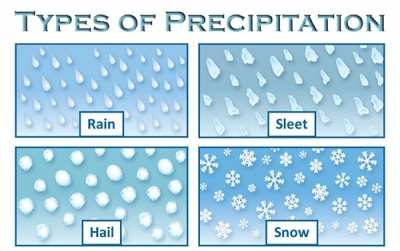
|
When water falls from clouds, whether it is in the form of rain, snow, sleet or hail, it is called precipitation. When the Sun heats up water on Earth’s surface, the water evaporates and travels into the atmosphere as water vapour. As the air rises and cools, this vapour becomes tiny drops of water again and falls to the ground as rain. If the temperature is below freezing, the droplets form tiny ice crystals that stick together to fall as snowflakes. |
Precipitation is any liquid or frozen water that forms in the atmosphere and falls back to the Earth. It comes in many forms, like rain, sleet, and snow. Along with evaporation and condensation, precipitation is one of the three major parts of the global water cycle.
Precipitation forms in the clouds when water vapor condenses into bigger and bigger droplets of water. When the drops are heavy enough, they fall to the Earth. If a cloud is colder, like it would be at higher altitudes, the water droplets may freeze to form ice. These ice crystals then fall to the Earth as snow, hail, or rain, depending on the temperature within the cloud and at the Earth’s surface. Most rain actually begins as snow high in the clouds. As the snowflakes fall through warmer air, they become raindrops.
Particles of dust or smoke in the atmosphere are essential for precipitation. These particles, called “condensation nuclei,” provide a surface for water vapor to condense upon. This helps water droplets gather together and become large enough to fall to the Earth.
Credit: National Geographic Society
Picture Credit : Google




